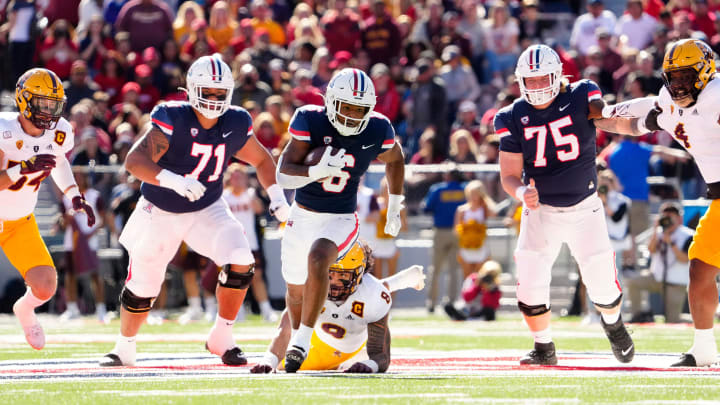Four Burning Questions As the Pac-12 Sits on the Brink

In this story:
So, what now? That’s the question many across college sports are asking after Oregon’s and Washington’s expected exit for the Big Ten, which, barring a late hangup, seems primed to occur. Here are four burning questions about the future of the Pac-12, or at least what’s left of it.
RIP, the Apple Cup and Civil War?
Realignment has been known to kill storied rivalries. Texas–Texas A&M (which realignment brought back), Bedlam, Missouri–Kansas among them. But perhaps it won’t kill Washington–Washington State and Oregon–Oregon State. Oregon and Washington are still going to need nonconference teams to play, and the Big Ten does not look kindly upon scheduling FCS teams as Oregon has on the schedule every year from 2025 to ’28. They also have Ohio State and Michigan State as nonconference games. Those are now, obviously, conference games, which means there will be slots on future schedules that will be filled. Florida and Georgia had nonconference games against Texas and Oklahoma, respectively, that were scrapped in response to the two Red River Rivals joining the SEC. All might not be lost for storied rivalry series in the future. That may also depend on the political will of both parties to continue to play (as came into the forefront specifically with Bedlam). But all might not be lost.
What the heck do the three remaining four corner schools do?
Arizona, Arizona State and Utah … it’s your move. It’s clear that at least Arizona seems primed to make the move to the Big 12, and sources in that league have considered the Wildcats the most movable in the days following Colorado’s plunge, but what about Arizona State and Utah? It seems clear that neither of these three schools wanted to be the ones that ended up killing the Pac-12 (the Pacific Northwest schools didn’t seem to be, either, but eventually Oregon and Washington pretty much did).
It’s up to Arizona State and Utah whether they think that staying in whatever remains of the Pac-12 is untenable. It’s likely that at least Arizona State will be swayed into thinking that it is. If they bolt to the Big 12, Brett Yormark’s gambit will have paid off, and the league will net two extra schools by simply being a logical home as the dust settles.
Can the Pac-12 soldier on, or will its carcass be picked by the artists perhaps formally known as the Group of 5?
This will be the biggest question in the aftermath once the dust settles between the (up to) seven defections to the Big Ten and Big 12. Is there a plausible world where Stanford, Oregon State, Washington State and Cal can stay together as a unit? It’s not likely. Adding San Diego State, UNLV, Boise State, SMU, Colorado State and others may get you near 10 teams across the region.
The reverse may also be in play. The Mountain West and perhaps even the American Athletic Conference could go on the hunt. There will be questions about whether Stanford’s and Cal’s academic sides would push back on such a move, but a league with Rice, Tulane, Tulsa and the Naval Academy may be academically prestigious enough at the top level. Stanford could also certainly go independent. Cal, a lot less so with its athletic department’s perpetual funding woes.
Will the Rose Bowl continue to exist? Can the travel work?
This is among the host of other logistical nightmares that the Big Ten will have to smooth over. Consider the 2024 football schedule announced earlier this summer dead and gone, as that will have to be ripped up and rethought of. Travel with just USC and UCLA was always going to be a headache, but working out how to include Oregon and Washington will be a process. In some ways it will help logistics to have other West Coast travel hubs, especially for nonrevenue sports, but there is still much to be worked on from that perspective. We also don’t know just yet which networks these games will be played on, for instance. The thought is the Big Ten would have to add another rights holder to handle the inventory—it’s unclear whether that’s going to happen. And that rights holder would probably be taking a bottom-tier package that might rarely, if ever, actually feature any of the heavyweights in the league.
And if the Pac-12 dies, there’s also a little game that’s sometimes an exhibition, sometimes part of the College Football Playoff. That is certainly not the only big, open question in the event the league literally shutters. What happens to the literal name Pac-12, for instance? Its contracts with venues for future events, its office space? These are beside the point of a proud league that may be at its end, but it is part of what will need to be unpacked in the coming days, weeks and months if the likely outcome to the end of this saga does in fact play out as it seems like it’s trending toward.

Richard Johnson is known for his college sports expertise. He co-hosts the “Split Zone Duo” podcast and co-authored The Sinful Seven: Sci-fi Western Legends of the NCAA. Richard was the 2022 winner of the Edward Aschoff Rising Star Award, and previously appeared as an analyst on the SEC Network show “Thinking Out Loud.” He established an early career with ESPN and SB Nation before joining Sports Illustrated in 2021 and lives in Brooklyn.
Follow RJ_cfb